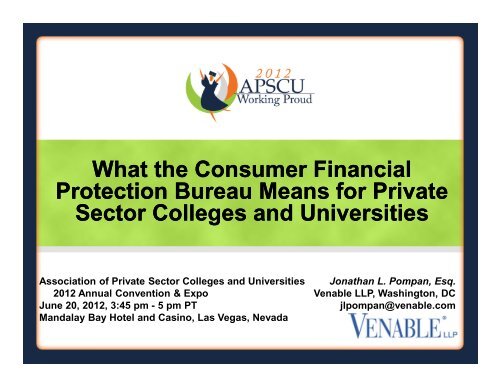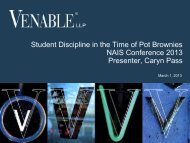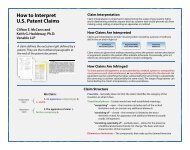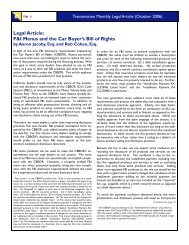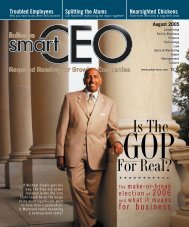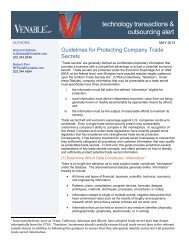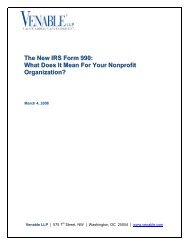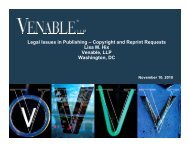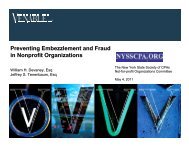What the Consumer Financial Protection Bureau ... - Venable LLP
What the Consumer Financial Protection Bureau ... - Venable LLP
What the Consumer Financial Protection Bureau ... - Venable LLP
Create successful ePaper yourself
Turn your PDF publications into a flip-book with our unique Google optimized e-Paper software.
<strong>What</strong> <strong>the</strong> <strong>Consumer</strong> <strong>Financial</strong><strong>Protection</strong> <strong>Bureau</strong> Means for PrivateSector Colleges and UniversitiesAssociation of Private Sector Colleges and Universities2012 Annual Convention & ExpoJune 20, 2012, 3:45 pm - 5 pm PTMandalay Bay Hotel and Casino, Las Vegas, NevadaJonathan L. Pompan, Esq.<strong>Venable</strong> <strong>LLP</strong>, Washington, DCjlpompan@venable.com
IMPORTANT INFORMATION ABOUT THISPRESENTATIONThis presentation is for general informational purposes only anddoes not represent and is not intended to provide legal advice oropinion and should not be relied on as such. Legal advice canonly be provided in response to specific fact situations.This presentation does not represent any undertaking to keeprecipients advised as to all or any relevant legal developments.This presentation will be available at www.venable.comTo view <strong>Venable</strong>’s index of articles and PowerPoint presentations onrelated legal topics, see www.<strong>Venable</strong>.com/cfpb/publications.
AGENDA• Introduction• The Dodd-Frank Wall Street Reform and <strong>Consumer</strong><strong>Protection</strong> Act – How we Got Here…• CFPB: Overview and Structure• CFPB: Focus on Private Educational Loans andStudents• CFPB: Preparing for Supervision and Examinations• CFPB: Navigating Investigations and Enforcement• CFPB: Whistleblowers and Service Providers• Coordination with O<strong>the</strong>r Federal and State Agencies• <strong>What</strong>’s Next for <strong>the</strong> CFPB and Private Schools?
INTRODUCTION• The new <strong>Consumer</strong> <strong>Financial</strong> <strong>Protection</strong> <strong>Bureau</strong> (“CFPB”) haslaunched a new era of regulation, supervision and initiativestargeted at private student loans and protecting service members.• The CFPB has supervision authority over private student lenders,enforces <strong>the</strong> laws against unfair student lending practices, andrequires lenders to follow <strong>the</strong> rules of <strong>the</strong> road and give students <strong>the</strong>information <strong>the</strong>y need to make smart choices about student loans.• The CFPB is promoting strong consumer financial protectionsfor servicemembers and <strong>the</strong>ir families.
WHAT’S THE COST OF NONCOMPLIANCE?Potentialcurtailmentof businessBadcustomerexperienceScrutiny byregulatorsMonetarypenalties•In today's rapidly changing regulatoryenvironment private schools areconfronted by a growing number ofcompliance challenges including difficultyfrom a resource perspective to address<strong>the</strong> many changes concurrently•Schools that invest in ongoing monitoringand conduct frequent monitoring as partof a mature compliance framework candrastically reduce <strong>the</strong> business andfinancial consequences associated withnoncomplianceLoss ofcustomersBranddamageLitigationsandlawsuits•In addition to immediate and short-termimpacts such as monetary losses,litigations and brand damage, schoolsalso risk negatively impacting <strong>the</strong>iraccreditation and rations with <strong>the</strong> CFPB,which in turn can affect <strong>the</strong> ability toexecute key growth strategies
THE CONSUMER PROTECTIONPYRAMIDLawEnforcementGovernmentRegulationEducation and SelfRegulation
WHERE DOES THE CFPB FIT IN WITH OTHER REGULATORS ANDGOVERNMENT AGENCIES?
DODD-FRANK WALL STREET REFORM ANDCONSUMER PROTECTION ACTAND THECONSUMER FINANCIAL PROTECTION BUREAUHOW WE GOT HERE….
DODD-FRANK ACT – HOW WE GOT HERE…• President signed Dodd-Frank Act into law on July 21, 2010.• Over 2,000 pages long.• Enacted in wake of <strong>the</strong> worst financial crisis since <strong>the</strong> GreatDepression.• Addresses a variety of issues that arose as a result of <strong>the</strong> crisis,including <strong>the</strong> perception that consumer protection wasfragmented and, in some cases inconsistent with o<strong>the</strong>r regulatoryfunctions.• Expected to generate more than 300 regulations.
DODD-FRANK ACT-HOW WE GOT HERE…<strong>Consumer</strong> <strong>Financial</strong> <strong>Protection</strong> Act of 2010• Title X of <strong>the</strong> Dodd-Frank Act.• Consolidates many federal consumer protectionresponsibilities into a new <strong>Bureau</strong> of <strong>Consumer</strong> <strong>Financial</strong><strong>Protection</strong> (not Agency)• Strips rulemaking authority for a host of federal consumerstatutes from o<strong>the</strong>r agencies and authorizes CFPB toprescribe uniform rules• Strips federally-chartered institutions of a significantdegree of charter preemption authority• Consolidates and Duplicates various supervisory andprogram authority areas related to nonbank products andservices, including private student loans.
CFPB: OVERVIEW AND STRUCTURE
CFPB: OVERVIEW AND STRUCTURECFPB STRUCTURENote:indicates notable office for private student lenders and service providers
CFPB: OVERVIEW AND STRUCTURECFPB FOCUS• Educate – “An informed consumer is <strong>the</strong> first line ofdefense against abusive practices.”• Enforce – “Like a neighborhood cop on <strong>the</strong> beat, <strong>the</strong>CFPB supervises banks, credit unions, and o<strong>the</strong>r financialcompanies, and we will enforce Federal consumerfinancial laws.”• Study – “The consumer bureau ga<strong>the</strong>rs and analyzesavailable information to better understand consumers,financial services providers, and consumer financialmarkets.”
CFPB: OVERVIEW AND STRUCTURECFPB Core Functions• Conduct rulemaking,supervision, andenforcement for Federalconsumer financialprotection laws• Restrict unfair,deceptive, or abusiveacts or practices• Take consumercomplaints• Promote financialeducation• Research consumerbehavior• Monitor financial marketsfor new risks toconsumers• Enforce laws that outlawdiscrimination and o<strong>the</strong>runfair treatment inconsumer finance
CFPB: OVERVIEW AND STRUCTURECFPB Staff Includes Experiences <strong>Consumer</strong><strong>Protection</strong> Attorneys and New Names“Most members of current staff have come fromo<strong>the</strong>r agencies. They include …Timothy R.Burniston, a senior associate director for <strong>the</strong>Federal Reserve’s consumer affairs division;Peggy L. Twohig, director of <strong>the</strong> office ofconsumer protection at Treasury; and Alice Hrdyand Lucy Morris from <strong>the</strong> Federal TradeCommission’s consumer protection division.”Source: Edward Wyatt, “Adviser to <strong>Consumer</strong> Agency Had Role in Lending,” NY Times(Oct. 27, 2010).
CFPB: OVERVIEW AND STRUCTUREStudent Debt, Student Loan, Servicemembers andOlder American Initiatives
CFPB: FOCUS ON PRIVATE STUDENT LOANSAND STUDENTS
CFPB FOCUS ON PRIVATE STUDENT LOANS1. Private Student Loan Ombudsman2. General <strong>Consumer</strong> Response Initiative3. Know Before You Owe: student loans and Student DebtRepayment Assistant4. Private Student Loan Market Study5. Servicemember Outreach and Education6. Rulemaking7. Supervision and Examination Authority over PrivateStudent Loans8. Investigation and Enforcement Authority
PRIVATE STUDENT LOAN OMBUDSMAN•Private student loanshad been overseen by apatchwork ofgovernment agencies.Rohit Chopra•Dodd-Frank establishedan Ombudsman forprivate student loanswithin <strong>the</strong> CFPB toassist borrowers withprivate student loancomplaints.20
CFPB: FOCUS ON STUDENTS<strong>Consumer</strong> Response Initiative• The <strong>Consumer</strong>Response teambegan takingconsumer complaintsabout private studentloans, and o<strong>the</strong>rconsumer loans onMarch 1, 2012.
CFPB: FOCUS ON STUDENTS• White House Student Loan Transparency Initiative• “We have heard from thousands of student loanborrowers who say that <strong>the</strong>y simply didn’t understandwhat <strong>the</strong>y signed up for. Many of <strong>the</strong>m chose privateloans before exhausting <strong>the</strong>ir cheaper federal loanoptions, which protect <strong>the</strong>m when <strong>the</strong>y run into trouble.Some resorted to credit cards and o<strong>the</strong>r high-pricedloans. And all too often, borrowers got in way over <strong>the</strong>irheads.” - Remarks of CFPB Director Richard Cordray at <strong>the</strong> White House (June 5, 2012)• 10 Schools Agree to Voluntary Disclosures:• Arizona State University, Miami Dade College, North CarolinaA&T, <strong>the</strong> State University System of New York, SyracuseUniversity, <strong>the</strong> University of Massachusetts system, <strong>the</strong>University of North Carolina at Chapel Hill, <strong>the</strong> University ofMaryland system, <strong>the</strong> University of Texas system, and VassarCollege
CFPB: FOCUS ON STUDENTSCFPB & DOE “Know Before You Owe:student loans”
CFPB: FOCUS ON STUDENTSStudent Debt Repayment Assistant
PRIVATE STUDENT LOAN MARKETSTUDY• The CFPB asked <strong>the</strong> public,students, families, <strong>the</strong> highereducation community, and <strong>the</strong>student loan industry – bothlenders and servicers – toprovide information on thisfinancial product voluntarily.•Information available to shop forprivate student loans•The role of schools in <strong>the</strong>marketplace•Underwriting criteria•Repayment terms and behavior•Impact on choice of field of studyand career choice•Servicing and loan modification•<strong>Financial</strong> education and defaultavoidance• Dodd-Frank requires <strong>the</strong> CFPBand <strong>the</strong> Department ofEducation to produce a reportto Congress by July 21, 2012.• The CFPB will also use <strong>the</strong>information it ga<strong>the</strong>rs toprioritize its own regulatoryand education work.Request for Information Regarding PrivateEducation Loans and Private EducationalLenders
CFPB SERVICEMEMBER AND VETERANINITIATIVESRepeat Offenders Against MilitaryDatabase (ROAM) - joint effort withstate Attorneys General and <strong>the</strong>Department of Defense to combatscams directed at servicemembers,veterans, and <strong>the</strong>ir families. ROAMis intended to track companies andindividuals who repeatedly target <strong>the</strong>military community. Law enforcementofficials across <strong>the</strong> country, includingstate Attorneys General, UnitedStates Attorneys, local officials, andJudge Advocates (JAGs), will be ableto contribute to and search <strong>the</strong>database.•Led by Holly Petraeus,Assistant Director forServicemember Affairs•Focused on uniquefinancial challenges ofservicemembers andveterans•Lending•Affinity Programs•Opportunities•Presidential ExecutiveOrder on “GI Bill”
CFPB REGULATION OF PRIVATEEDUCATIONAL LOANS• CFPB has specific supervisory authorityover any non-bank that offers or provide any“private educational loans” as defined inSection 140 of Truth in Lending Act (“TILA”).Section 1024(a)(1)(D).• Schools that extend credit to <strong>the</strong>ir studentsmay provide “private education loans” asdefined in TILA and Regulation Z.• Schools that assess finance charges on extensionsof credit are making “private education loans”unless term limited to 90 days or less.• Schools that do not assess finance charges butprovide for repayment term of more than 12 monthsare making private education loans.• Specific authority over “private educationlenders” supersedes “merchant exemption”• CFPB also has authority to supervisefinancial products and services that pose a“risk to consumers”
CFPB: Preparing for Supervisionand Examination
CFPB: PREPARING FOR SUPERVISIONAND EXAMINATIONAreas of Focus by <strong>the</strong> CFPB related to PrivateEducational Loans*•Unfair, Deceptive andAbusive Acts and Practices•Equal Credit OpportunityAct (ECOA) and Regulation•Truth in Lending Act•Electronic Fund TransferAct (15 U.S.C. 1693 et seq.)•Fair Credit Reporting Act(15 U.S.C. 1681et seq.)•Fair Debt CollectionPractices Act (15 U.S.C.1692 et seq.)•Gramm-Leach-Bliley Act of2009•Internal Revenue Code*(may report to <strong>the</strong> IRS)•State Statutory andRegulatory Requirements(may report to state AGs)* non-exhaustive list29
WHAT’S HAPPENING AT THE CFPB ONNONBANK SUPERVISION?• Dodd-Frank Supervision Authority – Under <strong>the</strong> law, <strong>the</strong>CFPB has authority to oversee nonbanks, regardless ofsize, in certain specific markets, including privateeducation lenders and <strong>the</strong>ir service providers ...• Supervision and Examination Manual• Attorney-Client Privilege and Attorney Work ProductConsiderations—CFPB Rulemaking Efforts
CFPB SUPERVISION ANDEXAMINATION• The statutory frameworks for supervision of large depository institutions and<strong>the</strong>ir affiliates and for non-depository consumer financial service companiesare largely <strong>the</strong> same.• The purpose of supervision, including examination, to:• assess compliance with Federal consumer financial laws,• obtain information about activities and compliance systems orprocedures, and• detect and assess risks to consumers and to markets for consumerfinancial products and services;• The requirement to coordinate with o<strong>the</strong>r Federal and state regulators; and• The requirement to use where possible publicly available information andexisting reports to Federal or state regulators pertaining to supervised entities.
SUPERVISION PROCESS PRINCIPLES• <strong>Consumer</strong> Focus: CFPB will focus on an institution’s ability to detect, prevent, andcorrect practices that present a significant risk of violating <strong>the</strong> law and causing consumerharm• Data Driven: Supervision staff (examiners and analysts) will use data from a wide range ofsources: data obtained from <strong>the</strong> entity and through direct observation during monitoring andexamination; information provided by <strong>the</strong> CFPB’s Research, Markets and Regulations and<strong>Consumer</strong> Education and Engagement divisions, <strong>the</strong> Office of Fair Lending and EqualOpportunity, <strong>the</strong> Enforcement division, <strong>Consumer</strong> Response Center, and Officesaddressing <strong>the</strong> special needs of students, Older Americans, Service members, and <strong>the</strong>underserved; and o<strong>the</strong>r state and Federal regulatory agencies.• Consistency: CFPB will use <strong>the</strong> same procedures to examine all supervised entities thatoffer <strong>the</strong> same types of consumer financial products or services, or conduct similaractivities.
CFPB EXAMINATION CYCLE
CFPB SUPERVISION ANDEXAMINATION MANUAL• The first part describes <strong>the</strong>supervision and examinationprocess.• The second part containsexamination procedures, includingboth general instructions andprocedures for determiningcompliance with specificregulations.• The third part presents templatesfor documenting information aboutsupervised entities and <strong>the</strong>examination process, includingexamination reports.
CFPB EXAMINATION STEPS• Collect and review available information(from within <strong>the</strong> CFPB, from o<strong>the</strong>r Federaland state agencies, and from publicsources), consistent with statutoryrequirements;• Request and review supplementarydocuments and information from <strong>the</strong> entityto be examined;• Develop and obtain internal approval for apreliminary risk focus and scope for <strong>the</strong>onsite portion of <strong>the</strong> examination;• Go onsite to observe, conduct interviews,and review additional documents andinformation;• Consult internally if <strong>the</strong> examinationindicates potential unfair, deceptive, orabusive acts or practices; discrimination; oro<strong>the</strong>r violations of law;• Draw preliminary conclusions about <strong>the</strong>regulated entity’s compliance managementand its statutory and regulatory compliance;• Consult internally about follow-up correctiveactions that <strong>the</strong> institution should take,whe<strong>the</strong>r through informal agreement or aformal enforcement action, if warranted byfindings;• Draft <strong>the</strong> examination report;• Obtain appropriate internal review andapproval for <strong>the</strong> examination work and draftexamination report;• Share <strong>the</strong> draft report with <strong>the</strong> prudentialregulator and obtain and consider anycomments <strong>the</strong>y may offer, consistent withstatutory requirements; and• After final internal clearance, finalize andtransmit <strong>the</strong> report to <strong>the</strong> supervised entity.• During <strong>the</strong> examination, <strong>the</strong> Examiner inCharge will communicate with appropriatesupervised entity personnel aboutpreliminary findings and conclusions.• CFPB will seek cooperation from <strong>the</strong> entityto correct any problems identified.
CFPB ENFORCEMENT AUTHORITY• CFPB is authorizedto conductinvestigations todetermine whe<strong>the</strong>rany person is, orhas, engaged inconduct thatviolates Federalconsumer financiallaw.• Investigationsmay beconducted jointlywith o<strong>the</strong>rregulators, andmay include:• subpoenas or civilinvestigativedemands fortestimony,• responses to writtenquestions,• documents, or• o<strong>the</strong>r materials
CFPB ENFORCEMENT AUTHORITY (CONT’D)• Rescission or reformation of contracts.• Refund of money or return of real property.• Restitution.• Disgorgement or compensation for unjustenrichment.• Payment of damages or o<strong>the</strong>r monetary relief.• Public notification regarding <strong>the</strong> violation.• Limits on <strong>the</strong> activities or functions of <strong>the</strong> personagainst whom <strong>the</strong> action is brought.• Civil monetary penalties (which can go ei<strong>the</strong>r tovictims or to financial education).
CFPB REFERRALS FROM EXAMS• Criminal Wrongdoing – Department of Justice• Tax Law Non-Compliance - The CFPB is alsorequired under <strong>the</strong> CFPA to refer informationidentifying possible tax law non-compliance to <strong>the</strong>Internal Revenue Service (IRS).• O<strong>the</strong>r Government Agencies
CFPB EXAM PROCESS IN DETAIL• For most full-scope examinations, <strong>the</strong> Examiner in Charge, ordesignee, contacts <strong>the</strong> supervised entity’s managementapproximately 60 days prior to <strong>the</strong> scheduled onsite date for <strong>the</strong>examination to arrange ei<strong>the</strong>r a telephone or in-persondiscussion of <strong>the</strong> examination Information Request.• The principal purpose of <strong>the</strong> discussion is to ga<strong>the</strong>r currentinformation to ensure that <strong>the</strong> request is tailored to what isnecessary to properly conduct <strong>the</strong> examination of that particularinstitution.• Examination – telephone, mail, in-person, combination• Closing Meeting• Examination Rating – 1 – 5 (1 is highest rating / lowest risk)• Examination Report – Corrective Action• Board of Directors / Principals Meeting39
WHAT WILL THE CFPB BE LOOKINGFOR?• Compliance ManagementSystem: A compliancemanagement system is how asupervised entity:•Establishes its complianceresponsibilities;•Communicates those responsibilitiesto employees;•Ensures that responsibilities formeeting legal requirements andinternal policies are incorporated intobusiness processes;•Reviews operations to ensureresponsibilities are carried out andlegal requirements are met; and•Takes corrective action and updatestools, systems, and materials asnecessary.ChecklistBoard and managementoversight;Compliance program Policies and procedures, Training, and Monitoring and correctiveaction.TrainingResponse to consumercomplaintsCompliance audit.
UNFAIR, DECEPTIVE OR ABUSIVEPRACTICES• Under <strong>the</strong> <strong>Consumer</strong> <strong>Financial</strong> <strong>Protection</strong> Act, it is unlawful forany provider of consumer financial products or services or aservice provider to engage in any unfair, deceptive or abusiveact or practice.• The Act also provides CFPB with rule-making authority and,with respect to entities within its jurisdiction, enforcementauthority to prevent unfair, deceptive, or abusive acts orpractices in connection with any transaction with a consumerfor a consumer financial product or service, or <strong>the</strong> offeringof a consumer financial product or service.• In addition, CFPB has supervisory authority for detectingand assessing risks to consumers and to markets forconsumer financial products and services
UNFAIR ACTS AND PRACTICESDEFINEDThe standard for unfairness in<strong>the</strong> CFPA is that an act orpractice is unfair when:1. It causes or is likely to causesubstantial injury toconsumers,2. The injury is not reasonablyavoidable by consumers, and3. The injury is not outweighedby countervailing benefits toconsumers or to competitionChecklistDoes an act or practice hinder aconsumer’s decision-making.The injury must not be outweighed bycountervailing benefits to consumersor competition.To be unfair, <strong>the</strong> act or practice mustbe injurious in its net effects — that is,<strong>the</strong> injury must not be outweighed byany offsetting consumer orcompetitive benefits that also areproduced by <strong>the</strong> act or practice.Offsetting consumer or competitivebenefits of an act or practice mayinclude lower prices to <strong>the</strong> consumeror a wider availability of products andservices resulting from competition.
DECEPTIVE ACTS OR PRACTICESDEFINEDA representation, omission, actorpractice is deceptive when1. The representation, omission,act, or practice misleads or islikely to mislead <strong>the</strong> consumer,2. The consumer’s interpretationof <strong>the</strong> representation,omission, act, or practice isreasonable under <strong>the</strong>circumstances, and3. The misleading representation,omission, act, or practice ismaterialChecklistActs or practices that may be deceptive include:making misleading cost or price claims; offering toprovide a product or service that is not in factavailable; using bait-and-switch techniques; omittingmaterial limitations or conditions from an offer; orfailing to provide <strong>the</strong> promised services.Is a representation, omission, act, or practice islikely to mislead:Is <strong>the</strong> statement prominent enough for <strong>the</strong>consumer to notice?Is <strong>the</strong> information presented in an easy-tounderstandformat that does not contradict o<strong>the</strong>rinformation in <strong>the</strong> package and at a time when <strong>the</strong>consumer’s attention is not distracted elsewhere?Is <strong>the</strong> placement of <strong>the</strong> information in a locationwhere consumers can be expected to look orhear?Finally, is <strong>the</strong> information in close proximity to<strong>the</strong> claim it qualifies?
ABUSIVE ACTS OR PRACTICESDEFINED• Materially interferes with <strong>the</strong> abilityof a consumer to understand a termor condition of a consumer financialproduct or service or• Takes unreasonable advantage of –•A lack of understanding on <strong>the</strong> part of <strong>the</strong>consumer of <strong>the</strong> material risks, costs, orconditions of <strong>the</strong> product or service;•The inability of <strong>the</strong> consumer to protect itsinterests in selecting or using a consumerfinancial product or service; or•The reasonable reliance by <strong>the</strong> consumeron a covered person to act in <strong>the</strong> interestsof <strong>the</strong> consumer.ExamplesThe TSR prohibits as anabusive practice requesting orreceiving any fee orconsideration in advance of:•debt relief services;•obtaining any credit repairservices;•recovery services, and•offers of a loan or o<strong>the</strong>rextension of credit, <strong>the</strong> grantingof which is represented as‘‘guaranteed’’ or having a highlikelihood of success
UDAAP ChecklistTo initially identify potential areas of UDAAP concerns, <strong>the</strong> CFPB will obtain and review copies of <strong>the</strong> following to<strong>the</strong> extent relevant to <strong>the</strong> examination: Training materials. Lists of products and services, including descriptions, fee structure, disclosures, notices, agreements, andperiodic and account statements. Procedure manuals and written policies, including those for servicing and collections. Minutes of <strong>the</strong> meetings of <strong>the</strong> Board of Directors and of management committees, including those related tocompliance. Internal control monitoring and auditing materials. Compensation arrangements, including incentive programs for employees and third parties. Documentation related to new product development, including relevant meeting minutes of Board ofDirectors, and of compliance and new product committees. Marketing programs, advertisements, and o<strong>the</strong>r promotional material in all forms of media (including print,radio, television, telephone, Internet, or social media advertising). Scripts and recorded calls for telemarketing and collections. Organizational charts, including those related to affiliate relationships and work processes. Agreements with affiliates and third parties that interact with consumers on behalf of <strong>the</strong> entity. <strong>Consumer</strong> complaint files. Documentation related to software development and testing, as applicable. Management Policies and Procedures Transaction testing Interviews with consumers
CFPB: NAVIGATING INVESTIGATIONSAND ENFORCEMENT
CFPB INVESTIGATIONS ANDENFORCEMENT• CFPB may investigate, issue subpoenas and civil investigativedemands, and compel testimony• CFPB may conduct hearings and adjudications to enforce compliance,including issuing cease-and-desist orders• CFPB may initiate actions for civil penalties or an injunction• Penalties up to $1M per day for knowing violations• No exemplary or punitive damages• Criminal referrals to DOJ• Whistleblower protection• State attorneys general may also enforce <strong>the</strong> CFPA with notice to <strong>the</strong>CFPB• May enforce rules issued by <strong>the</strong> FTC to <strong>the</strong> extent such rules apply to acovered a person or service provider• No express private right of action under <strong>the</strong> CFPA
EARLY WARNING NOTICE OFPOTENTIAL ENFORCEMENT•The Early Warning Notice isnot required by law, but CFPBbelieves it will promote evenhandedenforcement ofconsumer financial laws.•The decision to give notice inparticular cases isdiscretionary and will dependon factors such as whe<strong>the</strong>rprompt action is needed.
KEY STEPS TO RESPONDING TO ANINVESTIGATION1. Review <strong>the</strong> CID – A review of <strong>the</strong> CID,among many things, will identify <strong>the</strong>purpose of <strong>the</strong> investigation, <strong>the</strong> assignedstaff enforcement attorneys, <strong>the</strong>production deadline (e.g., 30 days fromissuance), <strong>the</strong> definitions, instructions, andinterrogatory and document requests.2. Establish a Response Team –• Ga<strong>the</strong>r documents and answersinterrogatory questions• Ensure compliance with legalobligations• Confidentiality• Assess whe<strong>the</strong>r responsive informationis privileged• Take proper steps to preserveresponsive materials (e.g.,implementation of a documentpreservation policy)• Avoid liability, and preventing futureclaims and damage to <strong>the</strong> company• In addition, a recipient of a CID willneed to decide whe<strong>the</strong>r publicdisclosure is required pursuant to o<strong>the</strong>rapplicable legal and regulatoryobligations.49
KEY STEPS TO RESPONDING TO ANINVESTIGATION (CONT’D)3. Assess <strong>the</strong> CID for PossibleModification Requests –• Once <strong>the</strong> team is assembled, legalcounsel needs to determine <strong>the</strong>scope and timing of <strong>the</strong> CIDresponse and whe<strong>the</strong>r anymodifications are needed.• The scope of <strong>the</strong> <strong>Bureau</strong>’s authorityin issuing <strong>the</strong> CID also needs to bedetermined.4. Meet and Confer with <strong>Bureau</strong>Enforcement Attorneys –• Within 10 days after receipt of <strong>the</strong>CID.
KEY STEPS TO RESPONDING TO ANINVESTIGATION (CONT’D)5. Petition to Modify orSet Aside <strong>the</strong> CID –• May file a petition tomodify or set aside aninformation request if<strong>the</strong> request is filed within20 days of receipt of <strong>the</strong>CID unless an extensionis granted by <strong>the</strong> headof <strong>the</strong> Office ofEnforcement.6. ElectronicallyStored Information –• The identification, collection,review, and processing ofelectronically storedinformation, such as emails,poses certain challenges onmost businesses.• The burden and costcontinues to increase as <strong>the</strong>amount of electronicallystored information that <strong>the</strong>average organization orcustodian regularly maintainscontinues to rise.
KEY STEPS TO RESPONDING TO ANINVESTIGATION (CONT’D)7. Production –• The CID instructions willcover specifics regardingproduction formats andlogistics.• Material that is withheldbased on asserting aprivilege is required to beidentified on a privilegelog.Notice and Opportunity toRespond and Advise• According to a bulletinpublished in January 2012,before <strong>the</strong> Office ofEnforcement recommendsthat <strong>the</strong> <strong>Bureau</strong> commenceenforcement proceedings,<strong>the</strong> Office of Enforcementmay give <strong>the</strong> subject ofsuch recommendationnotice of <strong>the</strong> nature of <strong>the</strong>subject’s potentialviolations and may offer<strong>the</strong> subject <strong>the</strong> opportunityto submit a writtenstatement in response.
CFPB SOLICITS WHISTLEBLOWERS• “We are providing whistleblowers ando<strong>the</strong>r knowledgeable sources with adirect line of communication to <strong>the</strong>CFPB,” said Rich Cordray, AssistantDirector of Enforcement for <strong>the</strong> CFPB.“Their tips will help inform <strong>Bureau</strong>strategy, investigations, andenforcement. And <strong>the</strong>y will help us fulfillour commitment to consumers.”• The whistleblower channels announcedinclude:• whistleblower@cfpb.gov;• (855) 695-7974; and• Website (to be launched)• The consumer finance whistleblowerprotections have significant implicationsfor legal and regulatory compliance andraise a number of challenges forproviders of consumer financial productsand services. Covered employers willneed to consider such issues as:• How to maintain legal and regulatory compliancewith consumer financial protection laws andregulations;• How to ensure that, to <strong>the</strong> extent <strong>the</strong>re is a violationof consumer financial protection law or regulations,an employee will take advantage of internalreporting mechanisms as opposed to bypassingsuch mechanisms and going straight to <strong>the</strong> CFPB;• How to conduct internal investigations withoutencouraging whistleblowers; and• How to successfully mediate any problemsdiscovered.
CFPB AND SERVICE PROVIDERS TOCOVERED FINANCIAL PRODUCTS ORSERVICES PROVIDERSService Providers may be liable under <strong>the</strong> CFPA for acts and practices thatviolate <strong>the</strong> law or assist o<strong>the</strong>rs in doing so. The CFPB recommends thatsupervised financial institutions take steps to ensure that businessarrangements with service providers do not present unwarranted risks toconsumers. According to <strong>the</strong> CFPB, <strong>the</strong>se steps include:1) Due Diligence;2) Requesting and reviewing <strong>the</strong> service provider’s policies, procedures,internal controls, and training materials;3) Appropriate contract provisions;4) Internal controls and on-going monitoring; and5) Taking prompt action to fully address any problems identified through <strong>the</strong>monitoring process.54
CONSUMER PROTECTION WORKINGGROUP• Announced in January 2012 (after State of <strong>the</strong> UnionAddress)• Unit within <strong>the</strong> <strong>Financial</strong> Fraud Enforcement Task Forcethat was created in late 2009, and is led by <strong>the</strong> U.S.Department of Justice (“DOJ”).• Will “address several areas of concern, including … forprofitschools that engage in fraud ormisrepresentation…”• CFPB, FTC, DOJ, DoE Inspector General, state AGs,and more are participating
WHAT’S NEXT AT THE CFPB ANDPRIVATE SCHOOLS? Know Before You Owe Refinement Increased push for voluntary adoption Examinations of Supervised Entities Investigations and Enforcement Nonbank Rulemaking Private Student Loan Study to Congress <strong>Consumer</strong> Arbitration Report and PossibleProhibition
FEBRUARY 2011
MAY 2012
QUESTIONS AND DISCUSSIONTo view <strong>Venable</strong>’s index of articles and PowerPoint presentations onrelated legal topics, see www.<strong>Venable</strong>.com/cfpb/publications.


